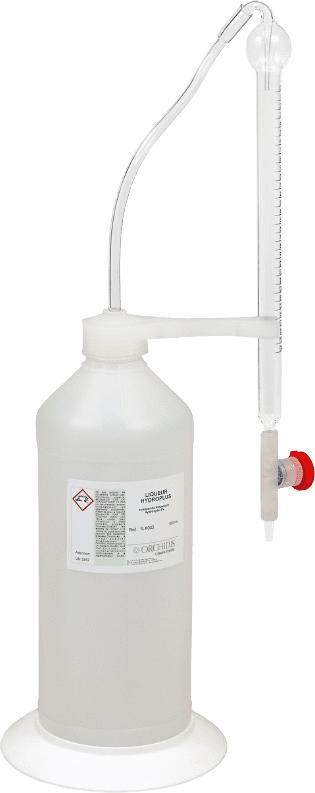
Burette hardness method
Description
Burette titration methods offer a greater titrant solution storage capacity, thereby increasing the number of tests and speed with which they can be performed.
Optional: burette with a stand or burette with bottle pressure fill.
Burette methods require a surface on which to place the burette. If you don’t have one, drop-counter methods are preferable.
The complexom titration method evaluates the hardness concentration of water by gradually adding the complexometric liquor to the sample. Before the equivalence point, the NET indicator is red; when the equivalence point is reached, it changes to blue.
Total Hardness (TH) of water is expressed in French degrees (°f), where 1°F corresponds to 10 mg of CaCO₃/L
Advantages
• Large scale reagents
• Burette with bottle pressure fill
• Suitable for frequent testing in an industrial environment.
• Suitable for all types of water
• Option to add your logo
Assets
• CMR-free
• Highly accurate
• Fast
• Affordable
Similar products
Why trust AQUALABO?
AQUALABO, a French company, offers a combination of experience, innovation, international presence, adaptability, and ecological commitment, making it a trusted partner for water quality control.
FAQ Burette hardness method 1MA302B
Why measure total hardness?
Measuring hardness is essential in assessing water quality. Hard water can lead to unwanted mineral deposits, affect the taste of drinks, and cause problems with household appliances. Soft water, on the other hand, can be corrosive and requires a delicate balance to prevent damage to your equipment.
What is the difference between carbonated and non-carbonated hardness?
Total hardness is the sum of carbonate and non-carbonate hardness. Carbonate hardness, due to calcium and magnesium bicarbonate, is sometimes called temporary hardness, and can be removed by boiling. Noncarbonate hardness, due to calcium and magnesium nitrates, chlorides, and sulfates, is also known as permanent hardness.
What fields require hardness monitoring?
Hardness monitoring is vital in many fields, including the food industry, cooling systems, boilers, and power generation. Water of a specific quality, with controlled hardness concentrations, is essential to ensure optimal efficiency of machinery and to extend its useful life. Specific applications include preventing scaling in water heaters, managing boiler water to prevent corrosion, and optimizing the performance of softening systems to eliminate the adverse effects of hardness on industrial processes.
What is the difference between hardness and alkalinity?
Hardness measures the concentration of calcium and magnesium ions, while alkalinity measures the ability of a solution to neutralize acids. Although related, hardness focuses on calcium and magnesium, while alkalinity includes the contribution of carbonate, bicarbonate, and hydroxide ions.
